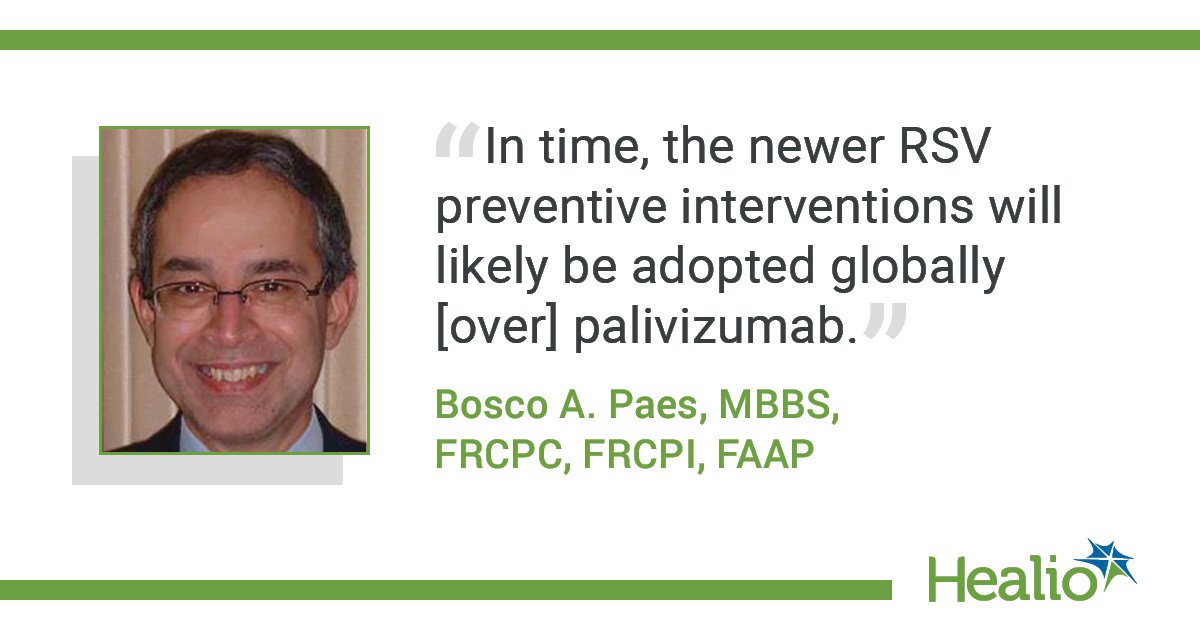Key takeaways:
- The cost of palivizumab varies across the world.
- The antibody was cost-effective in Canada, Colombia, Italy and South Korea.
Palivizumab was consistently found to be cost-effective as prophylaxis for respiratory syncytial virus disease among neonates on four continents, according to a study presented at the Pediatric Academic Societies Meeting.
Although palivizumab has been approved in the United States for more than 25 years for children at increased risk for serious lower respiratory tract disease caused by RSV, the AAP’s current guidance prefers a newer monoclonal antibody, nirsevimab, for this population “because of its efficacy, duration, and convenience,” according to the authors of the Red Book.
During last year’s shortage of nirsevimab, however, the CDC recommended that providers stop prescribing nirsevimab to children who were eligible for palivizumab, and instead immunize them with the older mAb, according to AAP guidance.
There is also now a maternal RSV vaccine available to protect infants from RSV.
According to the authors of the new study, the cost of palivizumab varies around the world, so they developed an evidence-based cost-utility model for their project that incorporates an International Risk Scoring Tool (IRST).
“In time, the newer RSV preventive interventions will likely be adopted globally [over] palivizumab,” Bosco A. Paes, MBBS, FRCPC, FRCPI, FAAP, professor emeritus in the division of neonatology at McMaster University in Hamilton, Ontario, study, told Healio.
“[But] palivizumab prophylaxis of infants born at 32 to 35 weeks’ gestational age guided by the IRST is consistently cost-effective across countries despite marked differences in economic, social and climatological factors,” Paes said.
Paes and colleagues enrolled infants aged between 32 and 35 weeks’ gestation in Canada, Colombia, Italy and South Korea who were identified as being at moderate or high risk for RSV-related hospitalization by the IRST.
The researchers used palivizumab efficacy data from the IMpact-RSV trial and country-specific parameters for hospital outcomes, costs and discounting rates.
The study showed that palivizumab was cost-effective at preventing neonatal RSV in all countries included in the study, with Canada saving the equivalent of around $21,000 per quality-adjusted life year (QALY), Colombia saving around $10,000 per QALY, Italy saving $14,600 per QALY, and South Korea saving $21,000 per QALY.
“We were pleased that the results confirmed our expectations that the IRST would serve as a useful guide to target RSV prophylaxis with palivizumab cost-effectively for moderate to late preterm infants who were at greatest risk for RSV” Paes said.
He did caution that the availability of gestational age-specific data on resource utilization and costs is absent in some countries, with a lack of long-term respiratory morbidity data beyond 6 years.
“Future, global studies should evaluate the cost-effectiveness of newer monoclonal antibodies [such as] nirsevimab and RSV vaccines vs. no prophylaxis in the prevention of severe RSV infection in all premature and term infants,” Paes said.
References:
AAP. AAP recommendations for prevention of RSV disease in infants and children. https://publications.aap.org/redbook/resources/25379/AAP-Recommendations-for-the-Prevention-of-RSV. Published Feb. 21, 2024. Accessed May 13, 2024.
CDC. Limited availability of nirsevimab in the United States — Interim CDC recommendations to protect infants from respiratory syncytial virus (RSV) during the 2023-2024 respiratory virus season. https://emergency.cdc.gov/han/2023/han00499.asp. Published Oct. 23, 2023. Accessed May 13, 2024.
Paes BA, et al. Abstract 64. Presented at: Pediatric Academic Societies Meeting; May 2-6, 2024; Toronto.
